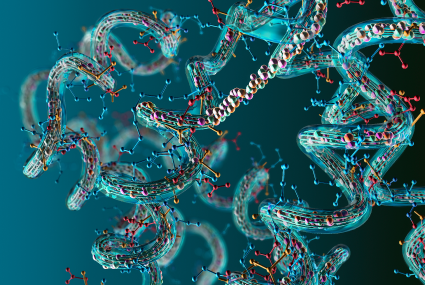Therapeutic Protein Engineering
Overview
Explore the various applications of synthetic biology through protein engineering. Using high-quality, high-fidelity DNA fragments, together with technologies like artificial intelligence and machine learning, discover how protein engineering enables rapid discovery and advancement.
Request a consultation
Working on protein or enzyme engineering? Your time is valuable and we’ll prioritize your inquiry. Click on “Request a consultation” to provide brief information about your project, and we’ll be in touch to discuss it ASAP.
Request a consultationWhat is protein engineering
Protein engineering is an application that takes advantage of synthetic biology, where engineering principles are applied to living systems with the goal of creating new protein versions with desirable traits. This includes altering the nucleic acid sequence that encodes an amino acid sequence. Each amino acid is linked together by non-covalent bonds, and they are assembled to form a peptide chain. By understanding a protein’s folding patterns and testing various conformations of the protein, researchers can engineer unique proteins with desirable properties for various purposes.
In protein engineering, altering the structure of the protein is dependent on the linear amino acid sequence and how the amino acids interact, which determines how the protein folds.
- A protein’s primary structure is defined as the amino acid sequence of its polypeptide chain.
- The secondary structure is the local spatial arrangement of a polypeptide’s backbone (main chain) atoms into alpha helixes or beta sheets.
- Tertiary structure refers to the three-dimensional structure of an entire polypeptide chain from side chain interactions.
- Quaternary structure is the three-dimensional protein structure arrangement of more than one amino acid chain subunit.
Proteins have diverse functions which depend on various characteristics and requirements of the cell. For instance, a structural protein is used to maintain a cell’s shape while an enzyme, another type of protein, is used for catalyzing a biochemical reaction occurring within a cell. Proteins are also involved in synthesizing and repairing DNA, transporting nutrients and molecules, receiving or sending chemical communication signals, and receiving or responding to stimuli [1].
For therapeutic protein engineering applications, the goal is to create a protein with increased potential for treating a disease while also ensuring minimal side effects. There are two approaches commonly applied in protein engineering. These approaches are directed evolution and rational design.
Directed evolution is a more conceptional and methodological approach that involves introducing gene mutations in a process known as mutagenesis. This approach follows a natural selection process and then evaluating the properties of the resulting variants and repeating in an iterative process.
Rational design is a hypothesis-driven approach based on a detailed understanding of the structure and subsequent function of a protein that contributes to its properties. This approach involves altering individual or multiple amino acid(s) generally at specific locations and then testing the variants to evaluate what characteristics may have changed.
Therapeutic applications of protein engineering
Therapeutic protein engineering has proven essential in modern medicine by engineering versions of a protein that are more efficient and targeted, leading to better therapies. They have advantages over small molecule drugs—performing more specific and complex functions and having less toxicity and likelihood of an unwanted immunogenicity.
Therapeutic protein engineering goes beyond monoclonal antibodies which specifically bind to a single target. Various applications include:
- Bispecific antibodies are complex antibody constructs with binding sites that are directed to different targets and can be customized to enhance functionality and efficacy. For complex diseases such as cancer, most bispecific antibodies engage the immune cells to destroy the malignant cells, deliver payload, or obstruct signals to the tumor [2].
- Antibody fragments are therapeutic proteins that are smaller, potent, and can be more effective than a standard antibody. Typical antibodies have two pairs of heavy-light chains and are comprised of two functional parts: the Fab region (binding site) and the Fc region (tail). A therapeutic antibody fragment may only contain the Fab region or single-chain variable fragment (ScFv) region. The smaller fragments can be delivered at a higher dose thus increasing the volume of target binding [3].
- mRNA therapeutics (mRNA vaccines) have a high therapeutic efficiency and low toxicity because mRNA transcripts can be transfected directly to the cell in vitro or in vivo. An mRNA transcript produces protein through the protein synthesis machinery. This mRNA-based approach has been implored for engineering mRNA vaccines for infectious diseases such as SARS-CoV-2 [4].
- Cell and gene therapies include CRISPR-Cas9 genome editing and CAR-T cell therapy which are two advantageous therapeutic options for treating diseases such as sickle cell disease and cancer. In the context of protein engineering, altering the genome editing protein Cas9 nuclease has been shown to improve the on-target DNA cleavage and overall editing efficiency [5]. For CAR-T therapy, strategies are evolving to improve the safety and efficacy of genetically engineered T cells that express chimeric antigen receptors (CARs).
- Antibody drug conjugates are comprised of a monoclonal antibody coupled with another therapeutic agent. For targeted cancer therapies, it’s advantageous to have a drug candidate that has a high specific target ability and potent cytotoxic effect [6].
- Enzyme replacement therapy offers useful and promising therapeutic options for a variety of metabolic diseases. By altering the key functions of the enzymes, such as the catalytic activity, target affinity, and specificity, engineered enzyme-based therapies can be applied to regulating various biological processes.
- Cell-free protein synthesis allows for scientists to generate proteins outside of living cells and is an innovative and cutting-edge technique for drug discovery. It can also enable the expression of proteins that cannot be expressed in living cells, due to for example, toxicity. A key feature is the ability to make proteins in a cell-free system that is not possible to make in living cells.
Challenges for Therapeutic Protein Engineering
Even with engineering, you often need to screen thousands of protein variants to find ones with higher efficiency and stability without side effects like loss of different functions or toxicity. Some of the difficulties include folding and protein stability, or the short half-life of non-endogenous proteins within the body.
Looking to the future with Artificial Intelligence (AI)
- AI helps design by predicting modifications likely to be successful. This can improve learning and future optimizations from the results of the testing.
- Machine learning (ML), AI algorithms, and databases such as the AlphaFold platform from DeepMind have already made huge strides in the field of therapeutic protein engineering and drug discovery. They’re continuing to get better with machine learning. This speeds up the Design-Build-Test-Learn (DBTL) cycle of synthetic biology.
- Access to databases with hundreds of thousands of unique protein structures to better understand and predict protein folding, specificity, toxicity, etc. has shortened the timeline for developing new therapies. Finding an effective therapeutic target can be like finding a needle in a haystack – AI and ML help shrink the haystack.
Learn more about how IDT can assist you in your next breakthrough discovery.
Workflow Solutions
Protein expression
Gene Editing/Engineering
Gene expression analysis
Methods for Antibody Discovery
Products for Therapeutic Protein Engineering
Explore resources
References
- Zaretsky JZ, Wreschner DH. Protein multifunctionality: principles and mechanisms. Transl Oncogenomics. 2008 May 15;3:99-136. PMID: 21566747; PMCID: PMC3022353.
- Suurs FV, Lub-de Hooge MN, de Vries EGE, de Groot DJA. A review of bispecific antibodies and antibody constructs in oncology and clinical challenges. Pharmacol Ther. 2019 Sep;201:103-119. doi: 10.1016/j.pharmthera.2019.04.006. Epub 2019 Apr 24. PMID: 31028837.
- Pirkalkhoran S, Grabowska WR, Kashkoli HH, Mirhassani R, Guiliano D, Dolphin C, Khalili H. Bioengineering of Antibody Fragments: Challenges and Opportunities. Bioengineering (Basel). 2023 Jan 17;10(2):122. doi: 10.3390/bioengineering10020122. PMID: 36829616; PMCID: PMC9952581.
- Qin S, Tang X, Chen Y, Chen K, Fan N, Xiao W, Zheng Q, Li G, Teng Y, Wu M, Song X. mRNA-based therapeutics: powerful and versatile tools to combat diseases. Signal Transduct Target Ther. 2022 May 21;7(1):166. doi: 10.1038/s41392-022-01007-w. PMID: 35597779; PMCID: PMC9123296.
- Banerjee T, Takahashi H, Subekti DRG, Kamagata K. Engineering of the genome editing protein Cas9 to slide along DNA. Sci Rep. 2021 Jul 8;11(1):14165. doi: 10.1038/s41598-021-93685-9. PMID: 34239016; PMCID: PMC8266852.
- Fu Z, Li S, Han S, Shi C, Zhang Y. Antibody drug conjugate: the "biological missile" for targeted cancer therapy. Signal Transduct Target Ther. 2022 Mar 22;7(1):93. doi: 10.1038/s41392-022-00947-7. PMID: 35318309; PMCID: PMC8941077.
- de la Fuente M, Lombardero L, Gómez-González A, Solari C, Angulo-Barturen I, Acera A, Vecino E, Astigarraga E, Barreda-Gómez G. Enzyme Therapy: Current Challenges and Future Perspectives. Int J Mol Sci. 2021 Aug 25;22(17):9181. doi: 10.3390/ijms22179181. PMID: 34502086; PMCID: PMC8431097.


 Processing
Processing


